Solution Processed NiO/MoS2 Heterostructure Nanocomposite for Supercapacitor Electrode Application
Abstract
1. Introduction
2. Materials and Methods
2.1. Synthesis of MoS2
2.2. Synthesis of NiO and NiO-MoS2 Composite
2.3. Working Electrode Preparation and Electrochemical Studies
2.4. Instrumentation
3. Results and Discussion
3.1. Structural Characterizations
3.2. Morphological Studies
3.3. Elemental Analysis
3.4. Electrochemical Characterizations
4. Conclusions
Supplementary Materials
Author Contributions
Funding
Data Availability Statement
Conflicts of Interest
References
- Global Energy Review 2021; International Energy Agency (IEA): Paris, France, 2021; p. 36.
- Dincer, I. Renewable Energy and Sustainable Development: A Crucial Review. Renew. Sustain. Energy Rev. 2000, 4, 157–175. [Google Scholar] [CrossRef]
- Halper, M.S. Supercapacitors: A Brief Overview; The MITRE Corporation: McLean, VA, USA, 2006; p. 41. [Google Scholar]
- Vangari, M.; Pryor, T.; Jiang, L. Supercapacitors: Review of Materials and Fabrication Methods. J. Energy Eng. 2013, 139, 72–79. [Google Scholar] [CrossRef]
- Xiao, J.; Li, H.; Zhang, H.; He, S.; Zhang, Q.; Liu, K.; Jiang, S.; Duan, G.; Zhang, K. Nanocellulose and Its Derived Composite Electrodes toward Supercapacitors: Fabrication, Properties, and Challenges. J. Bioresour. Bioprod. 2022, 7, 245–269. [Google Scholar] [CrossRef]
- Han, X.; Xiao, G.; Wang, Y.; Chen, X.; Duan, G.; Wu, Y.; Gong, X.; Wang, H. Design and Fabrication of Conductive Polymer Hydrogels and Their Applications in Flexible Supercapacitors. J. Mater. Chem. A 2020, 8, 23059–23095. [Google Scholar] [CrossRef]
- Wang, Y.; Zhang, L.; Hou, H.; Xu, W.; Duan, G.; He, S.; Liu, K.; Jiang, S. Recent Progress in Carbon-Based Materials for Supercapacitor Electrodes: A Review. J. Mater. Sci. 2021, 56, 173–200. [Google Scholar] [CrossRef]
- Kuo, S.-L.; Wu, N.-L. Investigation of Pseudocapacitive Charge-Storage Reaction of MnO2 ∙ NH2O Supercapacitors in Aqueous Electrolytes. J. Electrochem. Soc. 2006, 153, A1317. [Google Scholar] [CrossRef]
- Hu, C.-C.; Chang, K.-H.; Lin, M.-C.; Wu, Y.-T. Design and Tailoring of the Nanotubular Arrayed Architecture of Hydrous RuO2 for Next Generation Supercapacitors. Nano Lett. 2006, 6, 2690–2695. [Google Scholar] [CrossRef]
- Wu, S.; Hui, K.S.; Hui, K.N.; Kim, K.H. Ultrathin Porous NiO Nanoflake Arrays on Nickel Foam as an Advanced Electrode for High Performance Asymmetric Supercapacitors. J. Mater. Chem. A 2016, 4, 9113–9123. [Google Scholar] [CrossRef]
- Kumar, R.; Soam, A.; Sahajwalla, V. Carbon Coated Cobalt Oxide (CC-CO3O4) as Electrode Material for Supercapacitor Applications. Mater. Adv. 2021, 2, 2918–2923. [Google Scholar] [CrossRef]
- Chen, J.; Huang, K.; Liu, S. Hydrothermal Preparation of Octadecahedron Fe3O4 Thin Film for Use in an Electrochemical Supercapacitor. Electrochim. Acta 2009, 55, 1–5. [Google Scholar] [CrossRef]
- Rajendra Prasad, K.; Miura, N. Electrochemical Synthesis and Characterization of Nanostructured Tin Oxide for Electrochemical Redox Supercapacitors. Electrochem. Commun. 2004, 6, 849–852. [Google Scholar] [CrossRef]
- Wee, G.; Soh, H.Z.; Cheah, Y.L.; Mhaisalkar, S.G.; Srinivasan, M. Synthesis and Electrochemical Properties of Electrospun V2O5 Nanofibers as Supercapacitor Electrodes. J. Mater. Chem. 2010, 20, 6720–6725. [Google Scholar] [CrossRef]
- Vijayakumar, S.; Nagamuthu, S.; Muralidharan, G. Supercapacitor Studies on NiO Nanoflakes Synthesized Through a Microwave Route. ACS Appl. Mater. Interfaces 2013, 5, 2188–2196. [Google Scholar] [CrossRef] [PubMed]
- Dhas, S.D.; Maldar, P.S.; Patil, M.D.; Nagare, A.B.; Waikar, M.R.; Sonkawade, R.G.; Moholkar, A.V. Synthesis of NiO Nanoparticles for Supercapacitor Application as an Efficient Electrode Material. Vacuum 2020, 181, 109646. [Google Scholar] [CrossRef]
- Pore, O.C.; Fulari, A.V.; Parale, V.G.; Park, H.H.; Shejwal, R.V.; Fulari, V.J.; Lohar, G.M. Facile Hydrothermal Synthesis of NiO/RGO Nanocomposite Electrodes for Supercapacitor and Nonenzymatic Glucose Biosensing Application. J. Porous Mater. 2022, 29, 1991–2001. [Google Scholar] [CrossRef]
- Kong, D.-S.; Wang, J.-M.; Shao, H.-B.; Zhang, J.-Q.; Cao, C. Electrochemical Fabrication of a Porous Nanostructured Nickel Hydroxide Film Electrode with Superior Pseudocapacitive Performance. J. Alloys Compd. 2011, 509, 5611–5616. [Google Scholar] [CrossRef]
- Li, L.; Yang, H.; Yang, J.; Zhang, L.; Miao, J.; Zhang, Y.; Sun, C.; Huang, W.; Dong, X.; Liu, B. Hierarchical Carbon@Ni3S2@MoS2 Double Core–Shell Nanorods for High-Performance Supercapacitors. J. Mater. Chem. A 2016, 4, 1319–1325. [Google Scholar] [CrossRef]
- Jeevanandham, G.; Jerome, R.; Murugan, N.; Preethika, M.; Vediappan, K.; Sundramoorthy, A.K. Nickel Oxide Decorated MoS2 Nanosheet-Based Non-Enzymatic Sensor for the Selective Detection of Glucose. RSC Adv. 2020, 10, 643–654. [Google Scholar] [CrossRef]
- Joseph, N.; Shafi, P.M.; Bose, A.C. Recent Advances in 2D-MoS2 and Its Composite Nanostructures for Supercapacitor Electrode Application. Energy Fuels 2020, 34, 6558–6597. [Google Scholar] [CrossRef]
- Acerce, M.; Voiry, D.; Chhowalla, M. Metallic 1T Phase MoS2 Nanosheets as Supercapacitor Electrode Materials. Nat. Nanotech 2015, 10, 313–318. [Google Scholar] [CrossRef]
- Joseph, N.; Shafi, P.M.; Bose, A.C. Metallic 1T-MoS2 with Defect Induced Additional Active Edges for High Performance Supercapacitor Application. New J. Chem. 2018, 42, 12082–12090. [Google Scholar] [CrossRef]
- Geng, X.; Zhang, Y.; Han, Y.; Li, J.; Yang, L.; Benamara, M.; Chen, L.; Zhu, H. Two-Dimensional Water-Coupled Metallic MoS2 with Nanochannels for Ultrafast Supercapacitors. Nano Lett. 2017, 17, 1825–1832. [Google Scholar] [CrossRef] [PubMed]
- Ghasemi, F.; Jalali, M.; Abdollahi, A.; Mohammadi, S.; Sanaee, Z.; Mohajerzadeh, S. A High Performance Supercapacitor Based on Decoration of MoS2/Reduced Graphene Oxide with NiO Nanoparticles. RSC Adv. 2017, 7, 52772–52781. [Google Scholar] [CrossRef]
- Li, Z.; Qin, Z.; Zhang, W.; Li, Z. Controlled Synthesis of Ni(OH)2/MoS2 Nanohybrids for High-Performance Supercapacitors. Mater. Chem. Phys. 2018, 209, 291–297. [Google Scholar] [CrossRef]
- Luo, W.; Zhang, G.; Cui, Y.; Sun, Y.; Qin, Q.; Zhang, J.; Zheng, W. One-Step Extended Strategy for the Ionic Liquid-Assisted Synthesis of Ni3S4–MoS2 Heterojunction Electrodes for Supercapacitors. J. Mater. Chem. A 2017, 5, 11278–11285. [Google Scholar] [CrossRef]
- Yue, L.; Wang, X.; Sun, T.; Liu, H.; Li, Q.; Wu, N.; Guo, H.; Yang, W. Ni-MOF Coating MoS2 Structures by Hydrothermal Intercalation as High-Performance Electrodes for Asymmetric Supercapacitors. Chem. Eng. J. 2019, 375, 121959. [Google Scholar] [CrossRef]
- Kumar, C.; Das, S.; Jit, S. 7—Device Physics and Device Integration of Two-Dimensional Heterostructures. In 2D Nanoscale Heterostructured Materials; Jit, S., Das, S., Eds.; Micro and Nano Technologies; Elsevier: Amsterdam, The Netherlands, 2020; pp. 195–214. ISBN 978-0-12-817678-8. [Google Scholar]
- Saha, S.; Samanta, P.; Murmu, N.C.; Kuila, T. A Review on the Heterostructure Nanomaterials for Supercapacitor Application. J. Energy Storage 2018, 17, 181–202. [Google Scholar] [CrossRef]
- Wang, K.; Yang, J.; Zhu, J.; Li, L.; Liu, Y.; Zhang, C.; Liu, T. General Solution-Processed Formation of Porous Transition-Metal Oxides on Exfoliated Molybdenum Disulfides for High-Performance Asymmetric Supercapacitors. J. Mater. Chem. A 2017, 5, 11236–11245. [Google Scholar] [CrossRef]
- Ci, S.; Wen, Z.; Qian, Y.; Mao, S.; Cui, S.; Chen, J. NiO-Microflower Formed by Nanowire-Weaving Nanosheets with Interconnected Ni-Network Decoration as Supercapacitor Electrode. Sci. Rep. 2015, 5, 11919. [Google Scholar] [CrossRef]
- Rasamani, K.D.; Alimohammadi, F.; Sun, Y. Interlayer-Expanded MoS2. Mater. Today 2017, 20, 83–91. [Google Scholar] [CrossRef]
- Sahu, T.S.; Mitra, S. Exfoliated MoS2 Sheets and Reduced Graphene Oxide-An Excellent and Fast Anode for Sodium-Ion Battery. Sci. Rep. 2015, 5, 12571. [Google Scholar] [CrossRef] [PubMed]
- Yang, L.; Cui, X.; Zhang, J.; Wang, K.; Shen, M.; Zeng, S.; Dayeh, S.A.; Feng, L.; Xiang, B. Lattice Strain Effects on the Optical Properties of MoS2 Nanosheets. Sci. Rep. 2014, 4, 5649. [Google Scholar] [CrossRef] [PubMed]
- Swain, G.; Sultana, S.; Naik, B.; Parida, K. Coupling of Crumpled-Type Novel MoS2 with CeO2 Nanoparticles: A Noble-Metal-Free p–n Heterojunction Composite for Visible Light Photocatalytic H2 Production. ACS Omega 2017, 2, 3745–3753. [Google Scholar] [CrossRef] [PubMed]
- Zheng, J.; Zhang, R.; Wang, X.; Yu, P. Importance of Carbon Quantum Dots for Improving the Electrochemical Performance of MoS2@ZnS Composite. J. Mater. Sci. 2019, 54, 13509–13522. [Google Scholar] [CrossRef]
- Patterson, A.L. The Scherrer Formula for X-ray Particle Size Determination. Phys. Rev. 1939, 56, 978–982. [Google Scholar] [CrossRef]
- Siddique, M.N.; Ahmed, A.; Ali, T.; Tripathi, P. Investigation of Optical Properties of Nickel Oxide Nanostructures Using Photoluminescence and Diffuse Reflectance Spectroscopy. AIP Conf. Proc. 2018, 1953, 030027. [Google Scholar] [CrossRef]
- Mihaylov, M.; Chakarova, K.; Hadjiivanov, K. Formation of Carbonyl and Nitrosyl Complexes on Titania- and Zirconia-Supported Nickel: FTIR Spectroscopy Study. J. Catal. 2004, 228, 273–281. [Google Scholar] [CrossRef]
- Ritika; Kaur, M.; Umar, A.; Mehta, S.K.; Singh, S.; Kansal, S.K.; Fouad, H.; Alothman, O.Y. Rapid Solar-Light Driven Superior Photocatalytic Degradation of Methylene Blue Using MoS2-ZnO Heterostructure Nanorods Photocatalyst. Materials 2018, 11, 2254. [Google Scholar] [CrossRef]
- Vishnoi, P.; Sampath, A.; Waghmare, U.V.; Rao, C.N.R. Covalent Functionalization of Nanosheets of MoS2 and MoSe2 by Substituted Benzenes and Other Organic Molecules. Chem. Eur. J. 2017, 23, 886–895. [Google Scholar] [CrossRef]
- Wiston, B.R.; Ashok, M. Microwave-Assisted Synthesis of Cobalt-Manganese Oxide for Supercapacitor Electrodes. Mater. Sci. Semicond. Process. 2019, 103, 104607. [Google Scholar] [CrossRef]
- Mathis, T.S.; Kurra, N.; Wang, X.; Pinto, D.; Simon, P.; Gogotsi, Y. Energy Storage Data Reporting in Perspective—Guidelines for Interpreting the Performance of Electrochemical Energy Storage Systems. Adv. Energy Mater. 2019, 9, 1902007. [Google Scholar] [CrossRef]
- Kumuthini, R.; Ramachandran, R.; Therese, H.A.; Wang, F. Electrochemical Properties of Electrospun MoS2@C Nanofiber as Electrode Material for High-Performance Supercapacitor Application. J. Alloys Compd. 2017, 705, 624–630. [Google Scholar] [CrossRef]
- Wang, B.; Chen, J.S.; Wang, Z.; Madhavi, S.; Lou, X.W. Green Synthesis of NiO Nanobelts with Exceptional Pseudo-Capacitive Properties. Adv. Energy Mater. 2012, 2, 1188–1192. [Google Scholar] [CrossRef]
- Zhang, Z.J.; Xie, D.H.; Cui, P.; Chen, X.Y. Conversion of a Zinc Salicylate Complex into Porous Carbons through a Template Carbonization Process as a Superior Electrode Material for Supercapacitors. RSC Adv. 2014, 4, 6664. [Google Scholar] [CrossRef]
- Prakash, D.; Manivannan, S. N, B Co-Doped and Crumpled Graphene Oxide Pseudocapacitive Electrode for High Energy Supercapacitor. Surf. Interfaces 2021, 23, 101025. [Google Scholar] [CrossRef]
- Li, S.; Chen, T.; Wen, J.; Gui, P.; Fang, G. In Situ Grown Ni9S8 Nanorod/O-MoS2 Nanosheet Nanocomposite on Carbon Cloth as a Free Binder Supercapacitor Electrode and Hydrogen Evolution Catalyst. Nanotechnology 2017, 28, 445407. [Google Scholar] [CrossRef] [PubMed]
- Qin, Q.; Chen, L.; Wei, T.; Liu, X. MoS2/NiS Yolk–Shell Microsphere-Based Electrodes for Overall Water Splitting and Asymmetric Supercapacitor. Small 2019, 15, 1803639. [Google Scholar] [CrossRef]
- Zheng, S.; Zhang, J.; Deng, H.; Du, Y.; Shi, X. Chitin Derived Nitrogen-Doped Porous Carbons with Ultrahigh Specific Surface Area and Tailored Hierarchical Porosity for High Performance Supercapacitors. J. Bioresour. Bioprod. 2021, 6, 142–151. [Google Scholar] [CrossRef]
- Guo, W.; Guo, X.; Yang, L.; Wang, T.; Zhang, M.; Duan, G.; Liu, X.; Li, Y. Synthetic Melanin Facilitates MnO Supercapacitors with High Specific Capacitance and Wide Operation Potential Window. Polymer 2021, 235, 124276. [Google Scholar] [CrossRef]
- Wei, L.; Deng, W.; Li, S.; Wu, Z.; Cai, J.; Luo, J. Sandwich-like Chitosan Porous Carbon Spheres/MXene Composite with High Specific Capacitance and Rate Performance for Supercapacitors. J. Bioresour. Bioprod. 2022, 7, 63–72. [Google Scholar] [CrossRef]
- Li, H.; Liu, Y.-L.; Jin, H.; Cao, L.; Yang, H.; Jiang, S.; He, S.; Li, S.; Liu, K.; Duan, G. Bimetallic Salts Template-Assisted Strategy towards the Preparation of Hierarchical Porous Polyimide-Derived Carbon Electrode for Supercapacitor. Diam. Relat. Mater. 2022, 128, 109283. [Google Scholar] [CrossRef]
- Cao, L.; Li, H.; Xu, Z.; Gao, R.; Wang, S.; Zhang, G.; Jiang, S.; Xu, W.; Hou, H. Camellia Pollen-Derived Carbon with Controllable N Content for High-Performance Supercapacitors by Ammonium Chloride Activation and Dual N-Doping. ChemNanoMat 2021, 7, 34–43. [Google Scholar] [CrossRef]
- Wang, F.; Chen, L.; Li, H.; Duan, G.; He, S.; Zhang, L.; Zhang, G.; Zhou, Z.; Jiang, S. N-Doped Honeycomb-like Porous Carbon towards High-Performance Supercapacitor. Chin. Chem. Lett. 2020, 31, 1986–1990. [Google Scholar] [CrossRef]
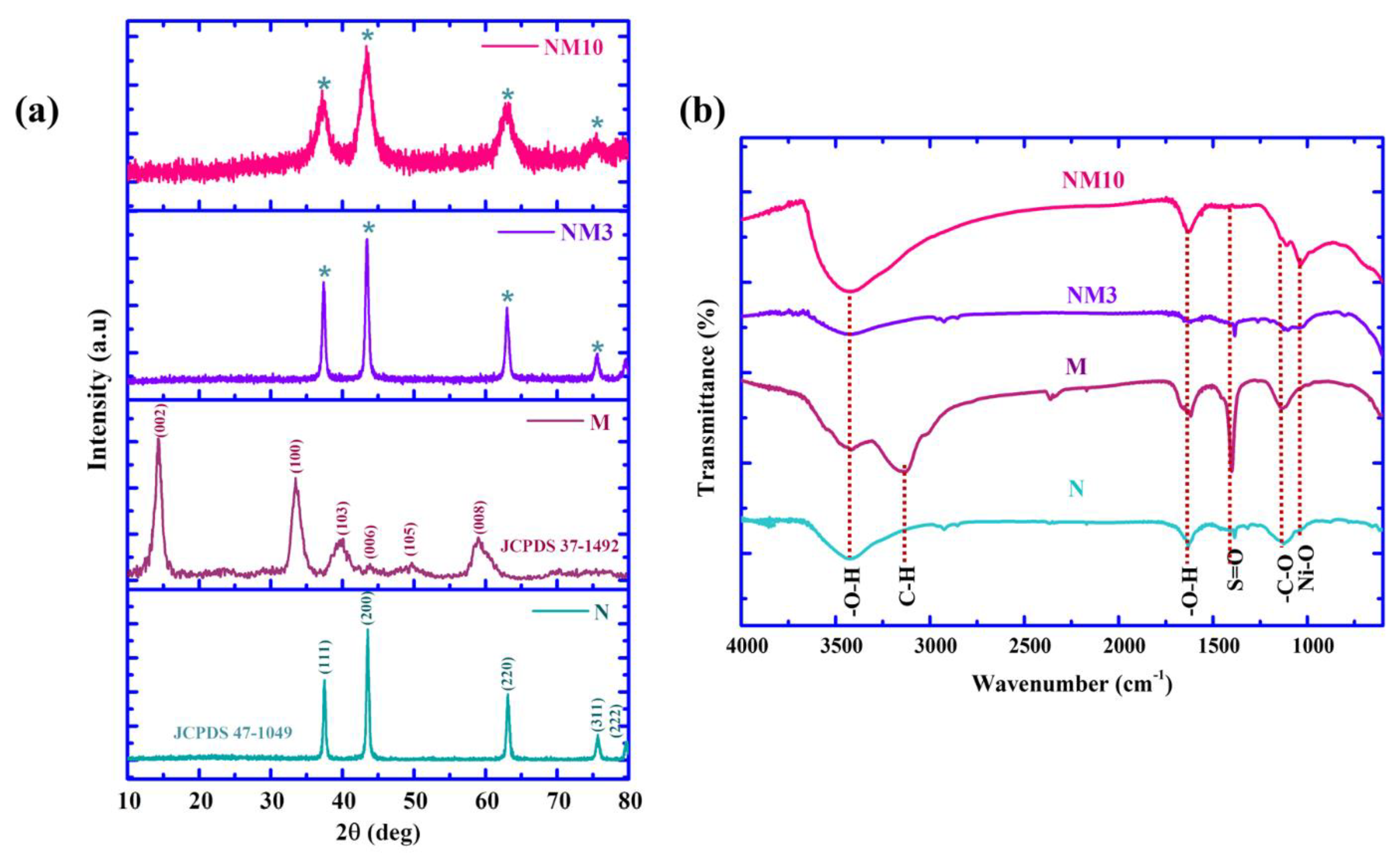
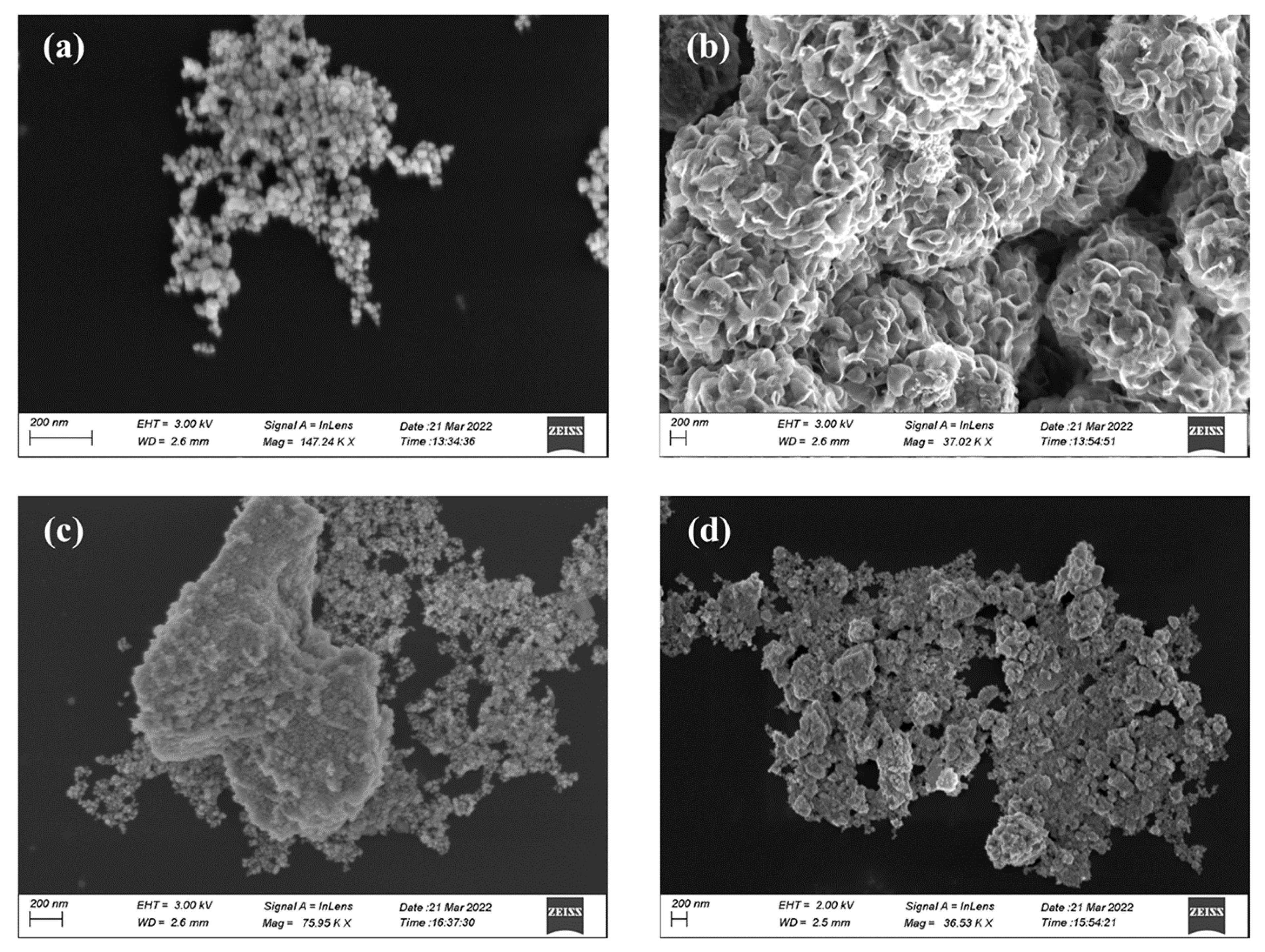

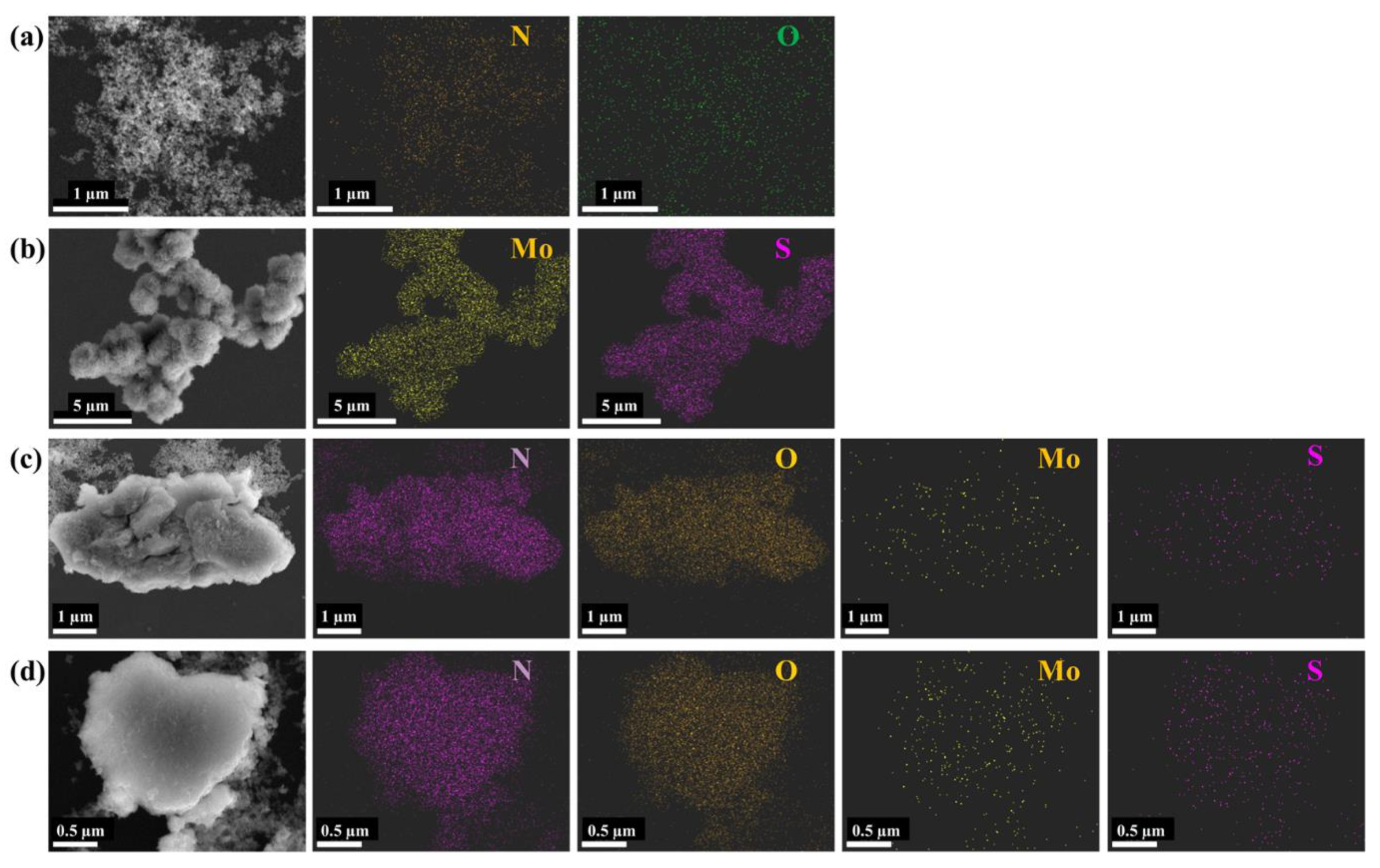
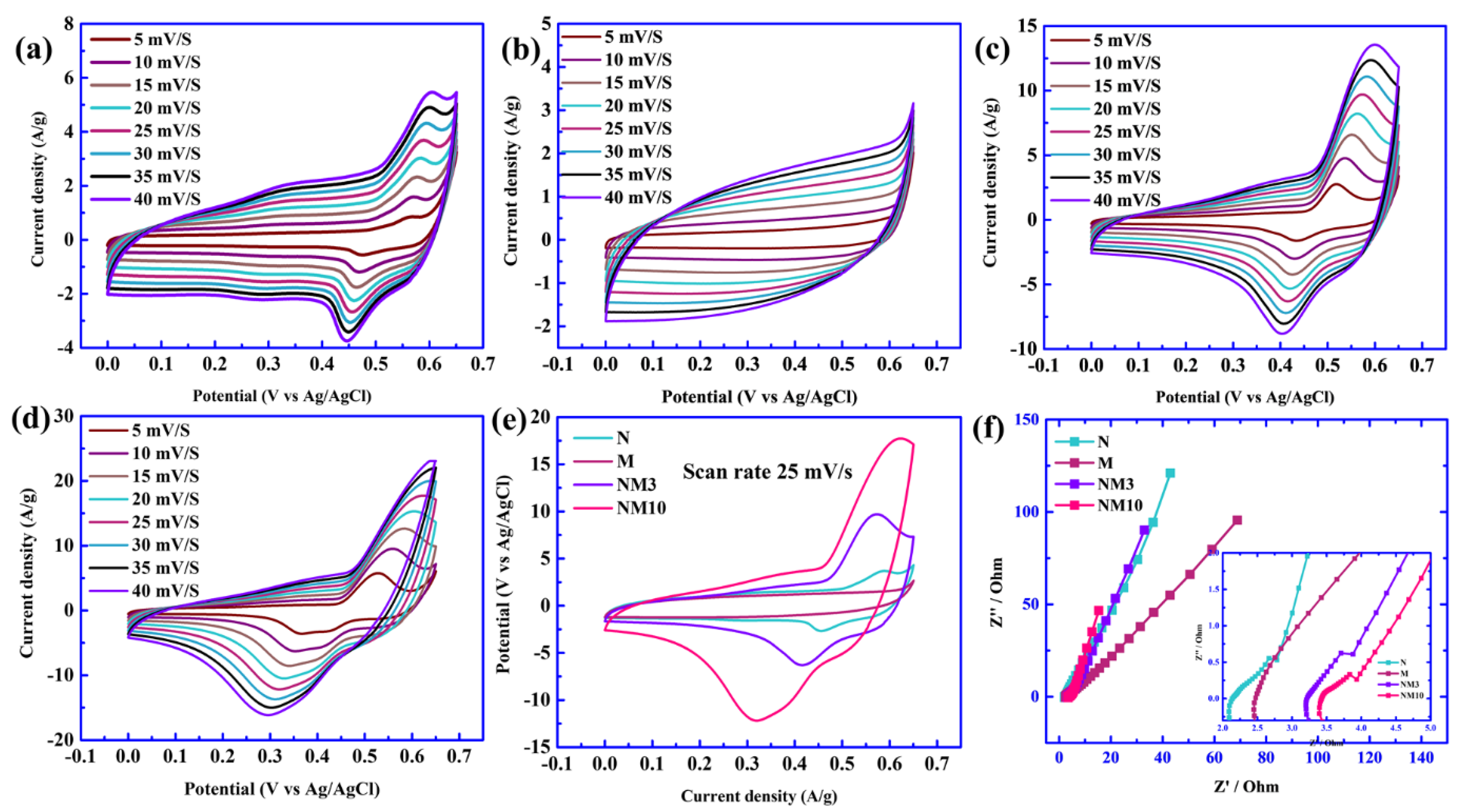
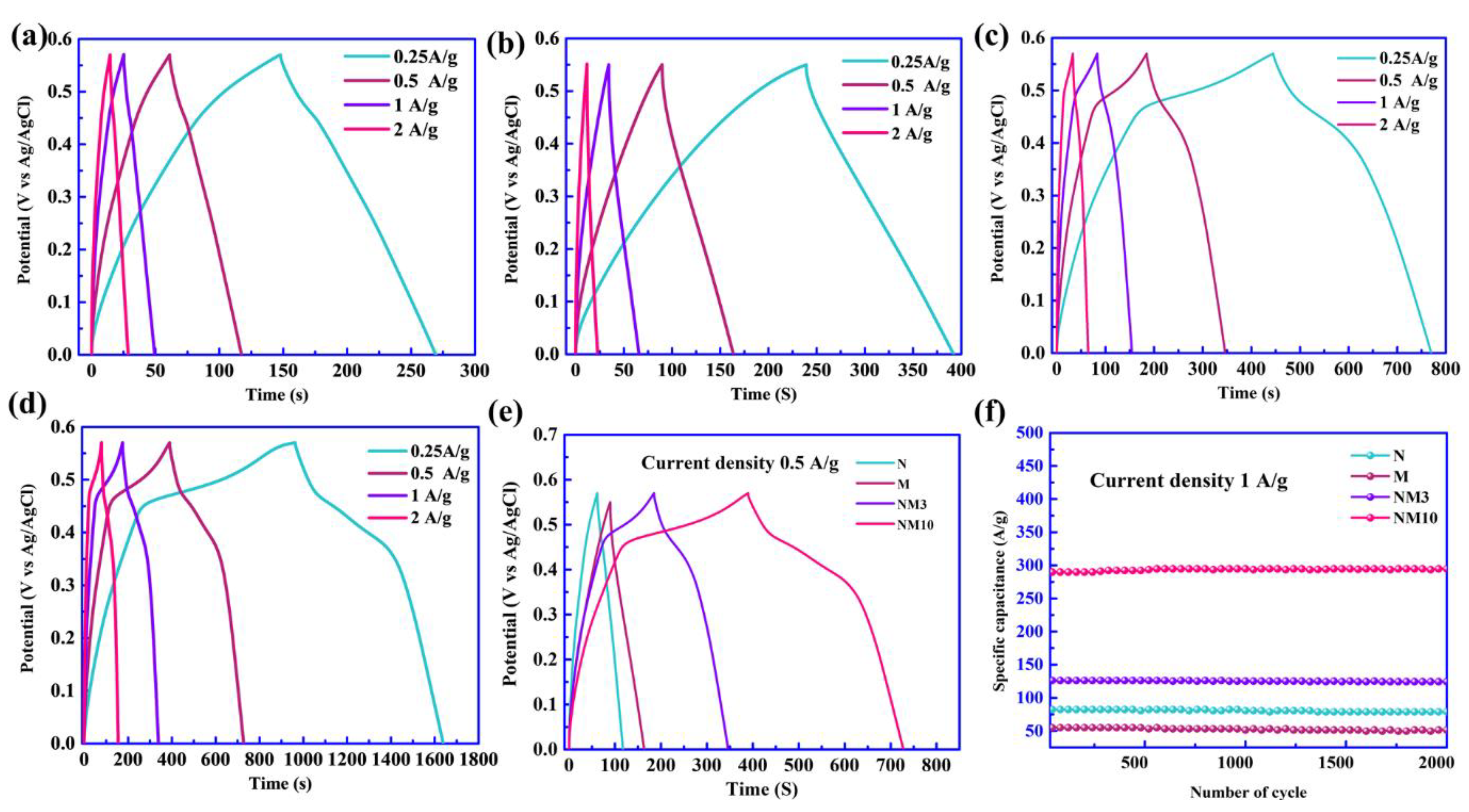

| Material | Current Density or Scan Rate | Electrolyte | Specific Capacitance | Retention | Reference |
|---|---|---|---|---|---|
| NiO nanoflakes | 0.5 Ag−1 | 2 M KOH | 409 Fg−1 | 92% after 500 cycles at current density 10 Ag−1 | [15] |
| NiO nanoparticles | 5 mVs−1 | 1 M KOH | 132 Fg−1 | 75% after 500 cycles at scan rate 5 mVs−1 | [16] |
| NiO/rGO composite | 1 mAcm−2 | 6 M KOH | 727.1 Fg−1 | 80% after 9000 cycles at current density 1 mAcm−2 | [17] |
| Metallic 1T-MoS2 | 1 Ag−1 | 1 M KOH | 379 Fg−1 | 92% after 3000 cycles at current density 1 A/g | [23] |
| Ni(OH)2/MoS2 | 5 mVs−1 | 6 M KOH | 201 mAhg−1 | 83% after 3000 cycles at current density 20 A/g | [26] |
| Ni3S4–MoS2 | 1 Ag−1 | 3 M KOH | 982.21 Fg−1 | 58% after 20,000 cycles at current density10 Ag−1 | [27] |
| Ni-MOF @ MoS2 | 1 Ag−1 | 3 M KOH | 1590.24 Fg−1 | 88% after 20,000 cycles at current density 5 Ag−1 | [28] |
| NiO nanobelts | 5 Ag−1 | 2 M KOH | 660 Fg−1 | 95% after 2000 cycles at current density 5 Ag−1 | [46] |
| Ni9S8/O-MoS2 nanocomposite | 2 Ag−1 | 1 M KOH | 907 Fg−1 | 86% after 1200 cycles at current density 2 Ag−1 | [49] |
| MoS2/NiS | 2 Ag−1 | 6 M KOH | 1165 Fg−1 | 100% after 10,000 cycles at current density 0.5 Ag−1 | [50] |
| Chitin-derived activated carbon | 0.5 Ag−1 | 1 M H2SO4 | 227 Fg−1 | 98% after 10,000 cycles at current density 10 Ag−1 | [51] |
| MnO@CNP-2 hybrid electrode | 0.5 Ag−1 | 6 M KOH | 545 Fg−1 | 87% after 3000 cycles at current density 10 Ag−1 | [52] |
| Chitosan porous carbon spheres/MXene | 0.5 Ag−1 | 1 M H2SO4 | 362 Fg−1 | 98% after 10,000 cycles at current density 10 Ag−1 | [53] |
| Hierarchical porous polyimide-derived carbon (CPC-Fe/Zn) | 1 Ag−1 | 6 M KOH | 420 Fg−1 | 92% after 1000 cycles at current density 20 Ag−1 | [54] |
| Camellia pollen activated carbon | 1 Ag−1 | 6 M KOH | 280 Fg−1 | 85% after 20,000 cycles at current density 20 Ag−1 | [55] |
| Porous carbon N-doped | 0.5 Ag−1 | 6 M KOH | 275 Fg−1 | 95% after 5000 cycles at current density 5 Ag−1 | [56] |
| NiO-MoS2 heterostructure | 1 Ag−1 | 1 M KOH | 289 Fg−1 | 101% after 2000 cycles at current density 1 Ag−1 | This work |
Disclaimer/Publisher’s Note: The statements, opinions and data contained in all publications are solely those of the individual author(s) and contributor(s) and not of MDPI and/or the editor(s). MDPI and/or the editor(s) disclaim responsibility for any injury to people or property resulting from any ideas, methods, instructions or products referred to in the content. |
© 2022 by the authors. Licensee MDPI, Basel, Switzerland. This article is an open access article distributed under the terms and conditions of the Creative Commons Attribution (CC BY) license (https://creativecommons.org/licenses/by/4.0/).
Share and Cite
Kasinathan, D.; Prabhakar, P.; Muruganandam, P.; Wiston, B.R.; Mahalingam, A.; Sriram, G. Solution Processed NiO/MoS2 Heterostructure Nanocomposite for Supercapacitor Electrode Application. Energies 2023, 16, 335. https://doi.org/10.3390/en16010335
Kasinathan D, Prabhakar P, Muruganandam P, Wiston BR, Mahalingam A, Sriram G. Solution Processed NiO/MoS2 Heterostructure Nanocomposite for Supercapacitor Electrode Application. Energies. 2023; 16(1):335. https://doi.org/10.3390/en16010335
Chicago/Turabian StyleKasinathan, Dhivyaprasath, Praveena Prabhakar, Preethi Muruganandam, Biny R. Wiston, Ashok Mahalingam, and Ganesan Sriram. 2023. "Solution Processed NiO/MoS2 Heterostructure Nanocomposite for Supercapacitor Electrode Application" Energies 16, no. 1: 335. https://doi.org/10.3390/en16010335
APA StyleKasinathan, D., Prabhakar, P., Muruganandam, P., Wiston, B. R., Mahalingam, A., & Sriram, G. (2023). Solution Processed NiO/MoS2 Heterostructure Nanocomposite for Supercapacitor Electrode Application. Energies, 16(1), 335. https://doi.org/10.3390/en16010335








